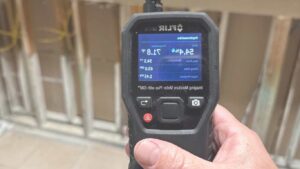Your home’s indoor air quality (IAQ) is crucial to your health and well-being. Many of us experience inexplicable health issues like recurring allergies, neurological conditions, respiratory complications, and more. It can sometimes be challenging to find the “smoking gun.” In this article, we explain the most common signs of poor IAQ and how to tell if your indoor air quality is making you sick.

Understanding Indoor Air Quality
Indoor Air Quality (IAQ) refers to the conditions of the air inside homes and commercial buildings. These conditions are measured according to their relation to the health and comfort of the occupants. Variables often measured to determine air quality include:
- Presence of pollutants
- Temperature
- Humidity
- Ventilation
- Overall cleanliness
“Good” IAQ implies that the air is free from excess harmful pollutants, and odors, is adequately ventilated, and maintains comfortable temperature and humidity levels.

Common pollutants found indoors include:
- Mold
- Volatile Organic Compounds (VOCs)
- Radon
- Dust
- Formaldehyde
Observing the presence of these pollutants is one way to know how to tell if your indoor air quality is making you sick.
Signs Your Indoor Air Quality Might Be Making You Sick
There are a couple of ways to tell if your indoor air quality is making you sick. These include the presence of:
- Physical symptoms
- Behavioral indicators
Physical Symptoms
Physical symptoms may include:
- Respiratory issues (e.g., coughing, wheezing, shortness of breath)
- Allergic reactions (e.g., sneezing, watery eyes, skin irritation)
- Headaches and dizziness
- Fatigue and lethargy
Behavioral Indicators
- Increased incidence of illness among household members
- Changes in mood or cognitive function
- Discomfort or unease when indoors
- Observing certain patterns over time
Assessing and Improving Indoor Air Quality
The first step to improve your IAQ is through proper assessment. This requires a professional IAQ assessor. These professionals are often referred to as “Mold Assessors” or “Mold Testers.” They have the proper knowledge, expertise, and advanced equipment to sample your air and diagnose its health. These are the proper steps:
- Conducting an IAQ assessment
- Implementing Corrective Measures
Conducting an IAQ assessment
Assessors will come to your home and identify potential sources of pollution or contaminants. They take air samples and surface samples and take note of the overall ventilation and cleanliness of the home or commercial space. The samples are then sent to a special lab for analysis. The goal is to determine not only the types of pollutants but also their specific concentration. The IAQ assessor then creates what is called a “Protocol” based on the results of the lab analysis and their assessment of the property.
In the state of Florida, assessors cannot also serve as remediators on the same case, so property owners can take the protocol from the assessment and contact a local remediation company.
Implementing corrective measures
Experienced mold remediation companies will implement ventilation improvements, set up necessary containment and air purification systems, conduct necessary demolition, install dehumidifiers, and give the property a detailed clean.

It’s important to hire a professional if you suspect that your indoor air quality is making you sick. This is one type of project you do not want to DIY.
Tips for Maintaining Healthy Indoor Air Quality
Here are a few tips to maintain a healthy IAQ moving forward:
- Regular maintenance of HVAC systems
- Proper ventilation practices
- Minimizing indoor pollutants
- Using indoor plants for natural air purification
- Lifestyle changes to support better IAQ
If You Suspect Your Indoor Air Quality Is Making You Sick, Flo-Air Is Here to Help
If you’re not sure how to tell if your indoor air quality is making you sick, it’s important to contact an IAQ professional. They have the necessary training and resources to determine the source of your issue and can create a strategy for solving the problem.
